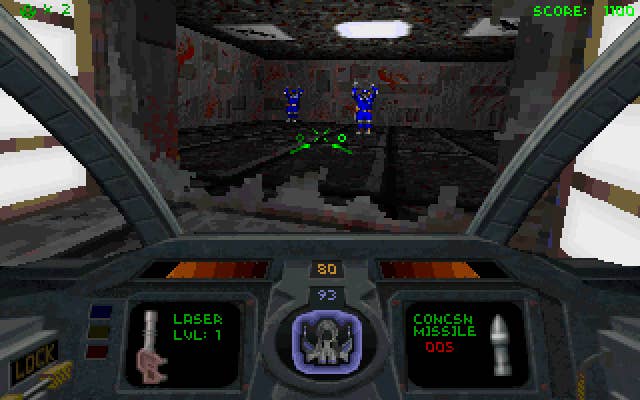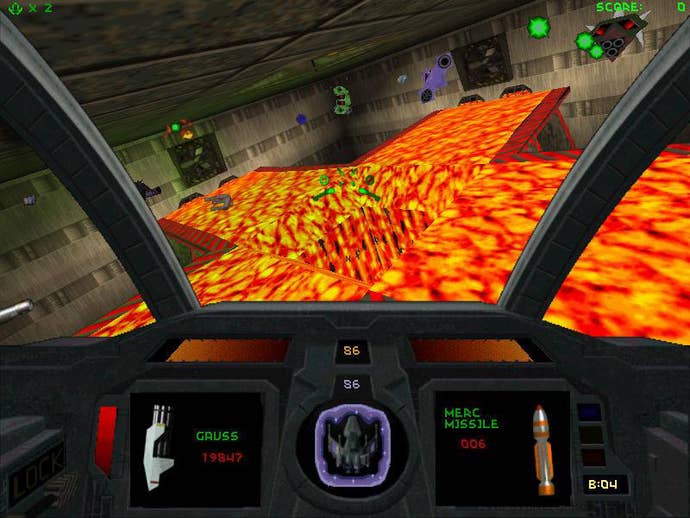Revisiting Descent, the Most Literal Interpretation of "3D Shooter"
With Descent back on Kickstarter, we revisit the game that embraced the concept of 3D gaming when everyone else was merely faking it.
This article first appeared on USgamer, a partner publication of VG247. Some content, such as this article, has been migrated to VG247 for posterity after USgamer's closure - but it has not been edited or further vetted by the VG247 team.
This article was originally run in March 2014. With Descent having recently celebrated its 20th anniversary, and a sequel seeking funding on Kickstarter, the time is ripe to revisit the game that embraced the concept of 3D gaming when everyone else was merely faking it.
You know how everyone always talks about how Quake was the first truly 3D first-person shooter (by which they mean "totally made out of polygons")? It's just video game trivia, so it's not worth getting into an argument about... but next time you hear someone mention that bit of information, smile to yourself and remember Descent.
Of course, I suppose it all boils down to how you choose to define "first-person shooter." Descent is a game in which you play from a first-person perspective and shoot things... but despite being based entirely in narrow corridors and allowing unconvention side-to-side movement, it does have more in common with a flight combat game (e.g. Lawrence Holland's X-Wing series) than with Doom. That is to say, your avatar isn't anchored by gravity, mainly. But on the other hand, the action revolves around small skirmishes in tight passageways and larger self-contained spaces, like your classic FPS. So which is it?

The answer, obviously, is "Who cares?" Descent stood astride two young genres, harnessing their concepts to create a unique mix. And when I say unique, I mean it – though Descent saw a number of sequels, after a while it mutated into the FreeSpace series, which featured 3D flight but abandoned the intricate tunnels that kept Descent from being a pure flight and combat simulator. Two decades later, you really won't find anything else quite like Descent out there.
The secret ingredient behind Descent's distinct style? It took the term "3D shooter" very literally. Not only did it present players with entirely polygonal environments in an age when everyone else was faking it by extruding chunks of flat surfaces into a facsimile of three-dimensionality, it went the extra step by completely abandoning all sense of up and down. Do you love the horizon? A sense of knowing the difference between up and down? The ability to orientate yourself with ease? Descent wants nothing to do with your terrestrial limitations.
Set in a series of extraplanetary mining tunnels, Descent dispensed with gravity to send players into labyrinthine tunnels that sprawled in every direction. Every direction. Not just the eight points of the compass, but in 360 degrees on every axis. Passageways would wind from one junction to another by twisting in any direction, sometimes doubling back on themselves. No matter how determined you may have been to set a given direction as "up," the complex level designs would quickly force you to abandon your intentions. Like a space flight sim, every direction was a valid axis of movement; unlike those other games, however, getting from point A to B frequently required navigating some of the most twisted virtual spaces ever devised.

In truth, Descent's movement wasn't truly free-form. Your actions were restricted to six axes – but given that this was four more than other shooters of the time allowed (remember, Doom didn't even let you manually aim up or down), that was more than enough to feel utterly dizzying. Thankfully, Descent was a much slower and more deliberate game than, say, Doom. The designers accounted for the fact that moving through the game world would probably leave you disoriented and possibly even dizzy, so most of the hazards that populated Descent's passages were fairly passive, giving you sufficient time to get your bearings and draw a bead on them. Descent was the sort of game that flight sticks were invented for. The multiplayer mode, however, offered no such grace – if you happened to go up against an opponent who took naturally to the game's discombobulating style, well, good luck.
You can certainly understand why Descent eventually faded and FreeSpace rose to take its place; its unconventional mechanics place a lot of demands on players. Running around on a 3D world consisting of flat surfaces can be taxing enough for many people; playing an even greater burden of virtual navigation and visual orienteering on them is asking quite a lot. Thankfully, Descent has remained in publication these many years and can easily be played on modern systems thanks to its ready availability through services like Steam and Desura. There are even more ambitious fanworks available as well, such as DXX-Rebirth. So check it out and consider yourself in the know next time someone opines about the history of 3D shooters. Just try not to look too smug about it.








